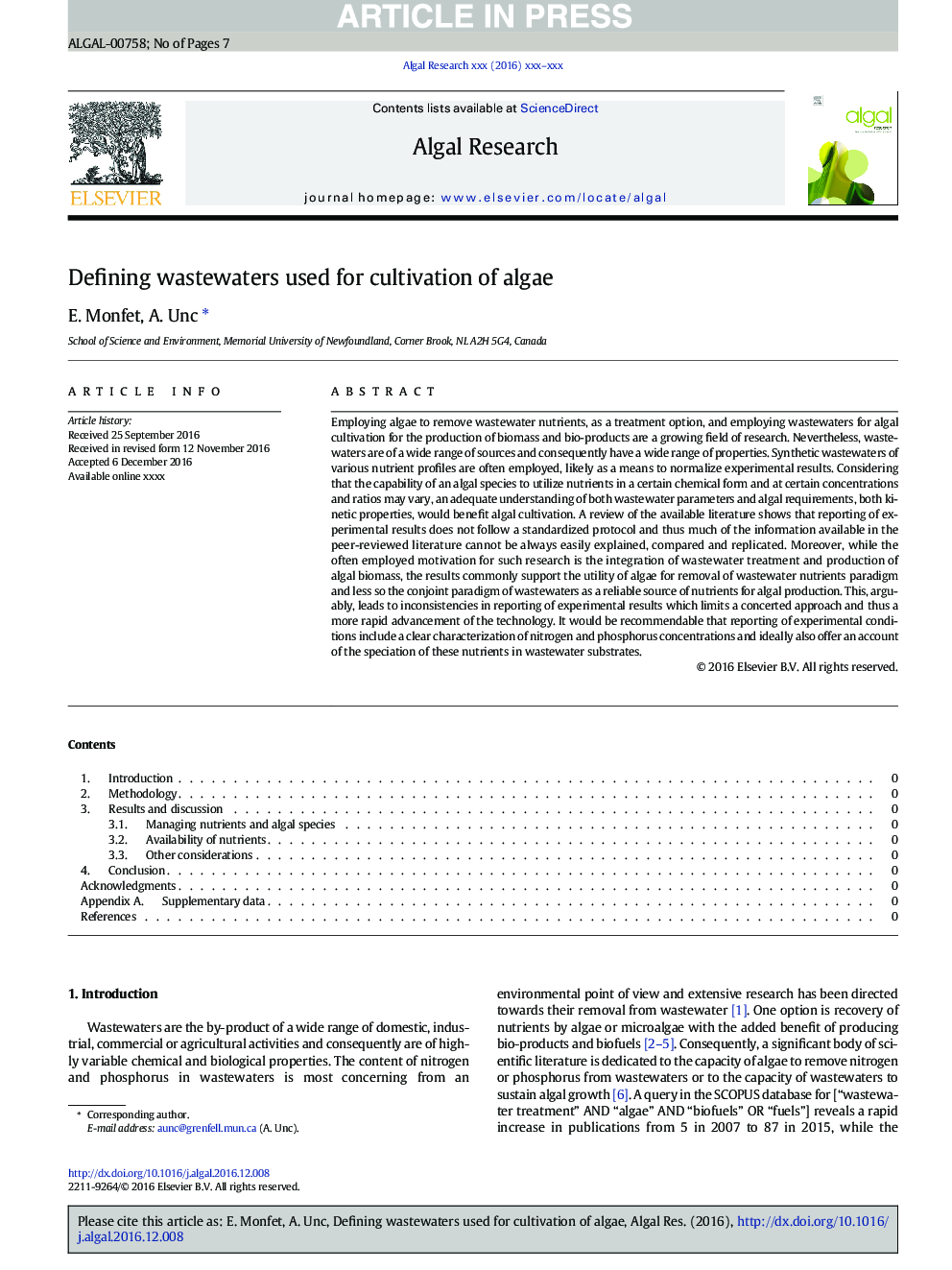| کد مقاله | کد نشریه | سال انتشار | مقاله انگلیسی | نسخه تمام متن |
|---|---|---|---|---|
| 5478259 | 1399261 | 2017 | 7 صفحه PDF | دانلود رایگان |
عنوان انگلیسی مقاله ISI
Defining wastewaters used for cultivation of algae
ترجمه فارسی عنوان
تعریف فاضلاب های مورد استفاده برای کشت جلبک ها
دانلود مقاله + سفارش ترجمه
دانلود مقاله ISI انگلیسی
رایگان برای ایرانیان
ترجمه چکیده
استفاده از جلبکها برای حذف مواد غذایی فاضلاب، به عنوان یک گزینه درمان، و استفاده از فاضلاب برای کشت جلبک برای تولید زیست توده و محصولات زیستی، یک رشته تحقیق در حال رشد است. با این حال، فاضلاب از طیف گسترده ای از منابع است و در نتیجه طیف گسترده ای از خواص. فاضلاب مصنوعی از پروفیل های مختلف مواد مغذی اغلب استفاده می شود، به احتمال زیاد به عنوان وسیله ای برای عادی کردن نتایج تجربی. با توجه به اینکه توانایی گونه های جلبک برای استفاده از مواد مغذی در یک فرم شیمیایی خاص و در برخی غلظت ها و نسبت های مختلف ممکن است متفاوت باشد، درک کافی از پارامترهای فاضلاب و شرایط جلبک، هر دو ویژگی های جنبشی، به نفع کشت جلبک. بررسی ادبیات موجود نشان می دهد که گزارش نتایج تجربی پیروی از یک پروتکل استاندارد نیست و در نتیجه بسیاری از اطلاعات موجود در ادبیات بررسی شده توسط همکاران نمی توانند همیشه به راحتی توضیح داده شوند، مقایسه و تکرار شوند. علاوه بر این، در حالی که انگیزه اغلب برای چنین تحقیقاتی ادغام تصفیه فاضلاب و تولید زیست توده جلبک است، نتایج معمولا از سود جلبک برای حذف پارامترهای مواد غذایی فاضلاب حمایت می کند و بنابراین پارادایم مشترک از فاضلاب به عنوان منبع قابل اعتماد مواد مغذی برای تولید جلبک. این، مسلما، منجر به عدم تطابق در گزارش نتایج تجربی است که محدود کردن یک رویکرد هماهنگ و بنابراین پیشرفت سریعتر از تکنولوژی است. توصیه می شود گزارشات شرایط آزمایش شامل مشخص بودن واکنش های غلظت نیتروژن و فسفر باشد و همچنین ایده آل برای ارزیابی ویژگی های این مواد مغذی در بسترهای فاضلاب باشد.
موضوعات مرتبط
مهندسی و علوم پایه
مهندسی انرژی
انرژی های تجدید پذیر، توسعه پایدار و محیط زیست
چکیده انگلیسی
Employing algae to remove wastewater nutrients, as a treatment option, and employing wastewaters for algal cultivation for the production of biomass and bio-products are a growing field of research. Nevertheless, wastewaters are of a wide range of sources and consequently have a wide range of properties. Synthetic wastewaters of various nutrient profiles are often employed, likely as a means to normalize experimental results. Considering that the capability of an algal species to utilize nutrients in a certain chemical form and at certain concentrations and ratios may vary, an adequate understanding of both wastewater parameters and algal requirements, both kinetic properties, would benefit algal cultivation. A review of the available literature shows that reporting of experimental results does not follow a standardized protocol and thus much of the information available in the peer-reviewed literature cannot be always easily explained, compared and replicated. Moreover, while the often employed motivation for such research is the integration of wastewater treatment and production of algal biomass, the results commonly support the utility of algae for removal of wastewater nutrients paradigm and less so the conjoint paradigm of wastewaters as a reliable source of nutrients for algal production. This, arguably, leads to inconsistencies in reporting of experimental results which limits a concerted approach and thus a more rapid advancement of the technology. It would be recommendable that reporting of experimental conditions include a clear characterization of nitrogen and phosphorus concentrations and ideally also offer an account of the speciation of these nutrients in wastewater substrates.
ناشر
Database: Elsevier - ScienceDirect (ساینس دایرکت)
Journal: Algal Research - Volume 24, Part B, June 2017, Pages 520-526
Journal: Algal Research - Volume 24, Part B, June 2017, Pages 520-526
نویسندگان
E. Monfet, A. Unc,
